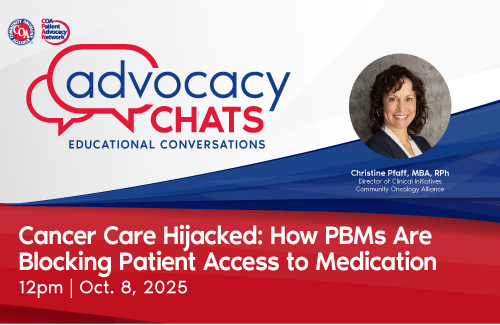How PBMs Are Blocking Patient Access to Medication
What Patients and Care Teams Can Do
When cancer is diagnosed, fear can be overwhelming. Many patients feel stuck until treatment starts, when a plan brings a measure of calm. That calm is shaken when outside forces step between the oncologist and the patient. Pharmacy benefit managers, or PBMs, increasingly insert delays, rules, and red tape that slow care and increase stress.
Celebrating National Pharmacist Month
Pharmacists are key to safe, timely cancer care. This month’s conversation put their role front and center by featuring a seasoned oncology pharmacist who now serves patients nationwide through COA.
Meet the Guest: Christine Pfaff, RPh, MBA
Christine Pfaff, COA’s Director of Clinical Initiatives, is new to COA but not to community oncology. A graduate of Ohio State University, she spent 20 years as an oncology pharmacist at the Zangmeister Cancer Center in Columbus, Ohio. She is deeply familiar with the pharmacy side of cancer care and the daily obstacles PBMs create.
Christine’s Role in Community Oncology
At Zangmeister, Christine worked within a care team that included nurses, pharmacists, a social worker, nurse practitioners, and physician assistants. Her focus was the clinic pharmacy, helping patients understand, obtain, and safely take the medications their oncologists prescribed.
How PBM Barriers Came into View
Despite years in practice, the scope of PBM interference surprised her. What started as simple claims processing has grown into a complex system that disrupts care.
The Emotional Reality of a Cancer Diagnosis
Host Rose Gerber, MS, spoke about the raw fear that follows a diagnosis. Many describe it as immobilizing despair. Relief often comes when treatment begins and a patient knows, “we have a plan.” PBM delays interrupt that progress and spike stress for patients, families, and care teams.
How PBMs Disrupt Cancer Treatment
PBMs sit between the oncologist, the pharmacy, and the insurer. They frequently slow or divert prescriptions, which intensifies anxiety. A common refrain among oncologists is that PBMs do not go to medical school, yet they weigh in on clinical choices. That interference delays treatment and chips away at trust.
PBMs as Unwanted Middlemen
The frustration is not abstract. Patients feel it in phone calls, denials, and delays. Christine and Rose urged advocates to stay connected and informed, since shared knowledge helps patients push back.
What Is a Pharmacy Benefit Manager?
A PBM is a third party that sits in the middle of the prescription drug process. PBMs interact with insurers, drug manufacturers, pharmacies, and patients.
- Design and manage formularies (the list of drugs an insurance plan will cover)
- Process and pay prescription drug claims (their original purpose)
- Own and operate mail-order or specialty pharmacies
- Negotiate drug prices and rebates with manufacturers
In oncology clinics, that middle layer often complicates what should be a direct path between the doctor’s order and the patient’s medication.
The PBM Model Has Shifted
PBMs began as a simple way to process claims. That simple reason to exist has morphed into a web of approvals, restrictions, and proprietary pharmacies that can delay care and add costs.
The Big Three PBMs
Three companies control the majority of the PBM market: CVS Caremark, Cigna with Express Scripts, and UnitedHealth Group with OptumRx. Together they handle more than 75 percent of PBM business.
Vertical Integration Raises Concerns
Many PBMs are owned by health insurance companies. For example, UnitedHealthcare owns OptumRx. Some PBMs also own specialty pharmacies and employ physicians. This consolidation signals an interest in working for profit, rather than centering the patient.
How PBMs Harm Cancer Patient Care
PBMs were supposed to reduce costs. In practice, their rules and structures often result in delays, higher out-of-pocket costs, and blocked access to what the doctor prescribed.
- Delays in care – through prior authorization and demands for extra medical documentation
- Restricted access – through narrow formularies that exclude needed drugs
- Higher costs – through fees and middle-layer charges that are hard to trace
For cancer, access to care quickly is very important. Patients need the therapy their oncologist recommends, delivered safely, at a cost they can manage.
When Delays Stretch into Weeks
Christine described typical prior authorization turnaround times of a few days to one or two weeks, with many cases dragging to multiple weeks or even months. During that time, pharmacists and technicians place repeated calls to insurers and PBMs while the clock ticks and anxiety rises.
Will Prior Authorizations Be Approved Anyway?
Rose asked a question many patients have, “Is the drug usually approved in the end?” Christine’s experience was, “Yes.” In her practice, treatment was ultimately approved in every case she recalled. But approval could take days, weeks, or even up to three months after multiple requests. The toll was real on:
- Patients and families
- Physicians and advanced practice providers
- Pharmacy staff and the wider clinic team
The Disruption Is Unnecessary
These are standard prescriptions for standard indications, written by specialists. The delays do not add value, they only disrupt necessary care. As Christine put it, “We feel that anxiety too.”
A Simple Analogy: If Your Coffee Shop Worked Like a PBM
Imagine buying a coffee; you pay $5 and leave with a hot cup of joe. Now imagine a middle layer that tells you where you must pick up your coffee, adds fees, reroutes the order, and asks the barista to justify your choice. This is the process a PBM forces patients to go through to receive care.
A Personal Story: When a PBM Blocked Care in Plain Sight
Christine shared a family experience that brings this home. Her father-in-law, Barry, was treated for colon cancer about 15 years ago at the clinic where she worked. His oncologist prescribed Xeloda, now available generically, a common oral chemotherapy with a complex dosing schedule. It required different pill sizes taken in the morning and evening, two weeks on and one week off.
The Clinic Pharmacy Had It, But Could Not Dispense It
The clinic pharmacy verified the prescription and started prior authorization. It was a standard treatment. Bottles were ready, but then they hit a wall. The PBM required that the prescription be sent to its own mail-order pharmacy. Christine was literally holding the medication yet could not give it to him.
The Wait Was Two Weeks, Without Guidance
The mail-order delivery arrived about two weeks later. There was no in-person teaching on dosing, food requirements, or side effects. In the clinic, Christine would have shown the pills, described when and how to take them, and offered a direct number for support. Instead, the family waited.
Practical Tips for Patients and Caregivers
There are steps you can take when a PBM steers a prescription away from your clinic pharmacy.
- Call your employer’s health plan benefits department
- Explain that your doctor’s office pharmacy has the medication ready and the need is urgent
- Ask for an override so the clinic can dispense it
- Follow up if you do not hear back quickly
This takes time and patience, but it can work. Many patients receive exceptions that allowed in-office dispensing.
Beyond One-Off Fixes: Push for Policy
Individual wins are important, but real relief comes when policy changes. Share your story at the state and federal levels. Tell lawmakers what prior authorization delays felt like, and how white bagging or prescription trolling affected your care. Laws do not pass overnight, but they prevent the next patient from facing the same barriers.
COA’s Advocacy, State Wins, and Upcoming Action
COA continues to educate lawmakers and support reforms that protect timely, local cancer care. Recent progress includes a PBM reform win in Arkansas. An Ohio statehouse visit is planned to lift patient and practice voices from community oncology. If you were treated in a community setting and want to participate, reach out through professional channels like LinkedIn to connect with Rose.
Why State Action Matters
Federal reform takes a long time. State reform takes time too, but often less. From 2018 to today, state PBM reforms have grown steadily. We can make a change; just be persistent.
Learn More and Get Involved
COA and CPAN share resources explaining PBMs and their impact on care, plus real patient stories from community practices across the country. Many CPAN chapters host PBM-focused lunch and learns or evening sessions featuring pharmacists, nurse leaders, and survivors. If your center does not have a chapter, consider starting one and invite a pharmacist to speak.
- Guest talks from clinic pharmacists help demystify prior authorization and specialty pharmacy rules
- Patient stories show the human cost of delays and denials
Conclusion
Cancer patients deserve fast, safe, and affordable access to the treatments their doctors prescribe. PBMs were meant to simplify, yet too often they delay care, restrict access, and raise costs. Learn the basics, tell your story, and push for change where you live. The path is clearer when we keep the patient at the center, keep pressure on policy, and keep treatment moving without unnecessary interruption.
CPAN Advocacy Chats are regular virtual 30-minute educational conversations about cancer advocacy and policy with a guest speaker invited to discuss issues important to patients and advocates. Summaries of previous Advocacy Chats are available on the CPAN website.
Past Advocacy Chats





